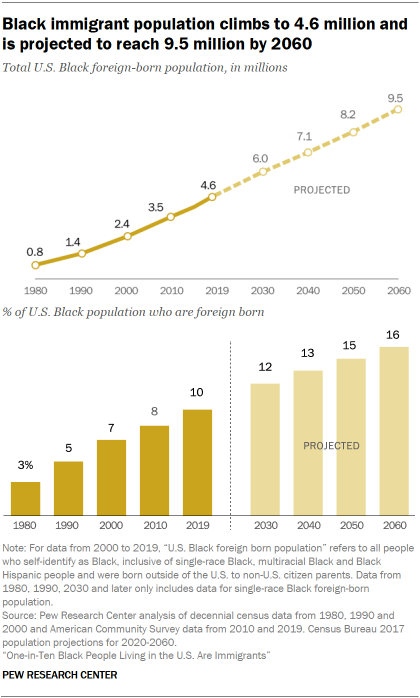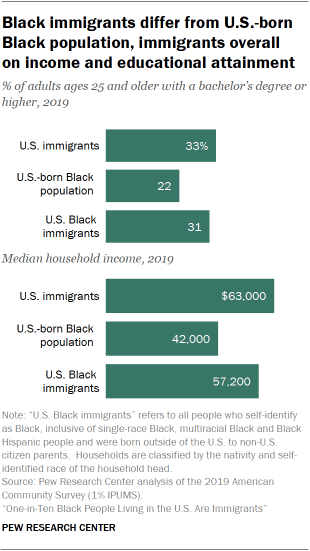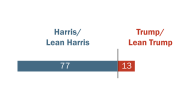Immigrants – particularly those from African nations – are a growing share of the U.S. Black population

The analysis presented in this report about the foreign-born Black population of the United States combines the latest data available from multiple data sources. It is mainly based on data from the U.S. Census Bureau’s 2006-2019 American Community Surveys (ACS) and the following U.S. decennial censuses provided through the Integrated Public Use Microdata Series (IPUMS) from the University of Minnesota: 1980 (5% sample), 1990 (5% sample) and 2000 (5% sample). U.S. Census population projections were used to estimate the size of the single-race Black foreign-born population from 2030 to 2060.
For census years 1980 and 1990, “Black immigrants” and “foreign-born Black population” refer to persons born outside the U.S., Puerto Rico or other U.S. territories whose sole self-identified race is Black, regardless of Hispanic origin. Prior to 2000, respondents to Census Bureau surveys and its decennial census could make only one selection in the race question. In 2000 and later, respondents were able to indicate they were of more than once race.
The ACS is used to present demographic characteristics for each group.
Analysis about the religious beliefs and practices of Black adults is based on the Faith Among Black Americans survey.
Analysis about immigrant generations utilizes the March 2019 Annual Social and Economic Supplement of the Current Population Survey. This data was collected before the COVID-19 pandemic.
U.S. Black population and Black population refer to all people who self-identify as Black in the United States. This includes those who say their race is only Black; those who say Black is one of two or more races in their background; and those who say their race is Black, or that one of their races is Black but also indicate they are of Hispanic or Latino or Black origin. The terms Black population and Black people are used interchangeably in this report.
The terms Black immigrants, the Black immigrant population, Black migrants and the foreign-born Black population are used interchangeably throughout the report and refer to persons who were both born outside the United States, Puerto Rico or other U.S. territories to parents neither of whom was a U.S. citizen, and who identify their race as Black. This is inclusive of those who say Black is one of two or more races in their background (regardless of Hispanic origin) in U.S. Census Bureau surveys from 2000 and later. For previous census years (1980 and 1990), “Black immigrants” and “foreign-born Black population” refer to persons born outside the U.S., Puerto Rico or other U.S. territories whose sole self-identified race is Black, regardless of Hispanic origin. Prior to 2000, respondents to Census Bureau surveys and its decennial census could make only one selection in the race question. In 2000 and later, respondents were able to indicate they were of more than once race.
U.S. born refers to those who are U.S. citizens at birth, namely people born in the U.S., Puerto Rico or other U.S. territories and those born abroad to at least one parent who was a U.S. citizen.
U.S. foreign born, U.S. migrants and U.S. immigrants refer to people born outside the U.S., Puerto Rico or other U.S. territories to parents neither of whom was a U.S. citizen. Unless otherwise specified, immigrant population estimates include all immigrants regardless of citizenship or legal status. The terms foreign born, migrant and immigrant are used interchangeably in this report.
Second generation refers to people born in the 50 states, the District of Columbia, Puerto Rico or other U.S. territories with at least one first-generation, or immigrant, parent.
Third generation or higher refers to people born in the 50 states, the District of Columbia, Puerto Rico or other U.S. territories with both parents born in the 50 states, the District of Columbia, Puerto Rico or other U.S. territories.
The lawful immigrant population is defined as naturalized citizens; people granted lawful permanent residence (previously known as legal permanent residence); those granted asylum; people admitted as refugees; and people admitted under a set of specific authorized temporary statuses for longer-term residence and work.
Unauthorized immigrants are all foreign-born noncitizens residing in the country who are not lawful immigrants. These definitions reflect standard and customary usage by the U.S. Department of Homeland Security and academic researchers. The vast majority of unauthorized immigrants entered the country without valid documents or arrived with valid visas but stayed past their visa expiration date or otherwise violated the terms of their admission. Some who entered as unauthorized immigrants or violated terms of admission have obtained work authorization by applying for asylum or adjustment to lawful permanent status, obtaining Temporary Protected Status (TPS) or receiving Deferred Action for Childhood Arrivals (DACA) status. This “quasi-lawful” group could account for as much as 10%-15% of the unauthorized population. Many could also revert to unauthorized status.
In this report, the terms African immigrants, African-born immigrants and immigrants born in Africa are used to describe any immigrants who self-identify as Black and are from any country on the African continent, regardless of sub-region. For a full list of countries in this region, please refer to Appendix A.
In this report, Caribbean immigrants, Caribbean-born immigrants and immigrants born in the Caribbean are any immigrants who self-identify as Black and are from any country in this region. For a full list of countries in this region, please refer to Appendix A.
In this report, the terms Central American immigrants, Central American-born immigrants and immigrants born in Central America are used to refer to any immigrants who self-identify as Black and are from any country in this region. For a full list of countries in this region, please refer to Appendix A.
In this report, the terms South American immigrants, South American-born immigrants and immigrants born in South America are used to refer to any immigrants who self-identify as Black and are from any country in this region. For a full list of countries in this region, please refer to Appendix A.
The Black population of the United States is diverse, growing and changing. The foreign-born segment of this population has played an important role in this growth over the past four decades and is projected to continue doing so in future years.
Roughly 4.6 million, or one-in-ten, Black people in the U.S. were born in a different country as of 2019, up from 3% in 1980. By 2060, the U.S. Census Bureau projects that this number will increase to 9.5 million, or more than double the current level (the Census Bureau only offers projections for single race groups).
Between 1980 and 2019, the nation’s Black population as a whole grew by 20 million, with the Black foreign-born population accounting for 19% of this growth. In future years, the Black immigrant population will account for roughly a third of the U.S. Black population’s growth through 2060, according to a new Pew Research Center analysis of U.S. Census Bureau data.
The Black immigrant population is also projected to outpace the U.S.-born Black population in growth. While both groups are increasing in number, the foreign-born population is projected to grow by 90% between 2020 and 2060, while the U.S.-born population is expected to grow 29% over the same time span.
Migration from Africa has fueled the bulk of the growth of the Black foreign-born population from 2000 onward. In 2000, roughly 560,000 African-born Black immigrants lived in the U.S. By 2019, that number had more than tripled to over 1.9 million. And many of these immigrants are newer arrivals to America: 43% of African-born Black immigrants immigrated to the U.S. from 2010 to 2019, higher than the shares among all U.S. immigrants (25%) and Black immigrants from the Caribbean (21%), Central America (18%) and South America (24%) in the same time period.
At the same time, a notable share of Black Americans today are the offspring of immigrants. Roughly 9% of Black people are second-generation Americans – meaning they were born in the U.S., but have at least one foreign-born parent, according to a Center analysis of the March supplement of the Census Bureau’s 2019 Current Population Survey. In total, Black immigrants and their U.S.-born children account for 21% of the overall Black population.
When it comes to socioeconomic factors, Black immigrants stand out from the U.S.-born Black population and the overall U.S. immigrant population on some measures, such as household income and educational attainment.
For example, a larger share of Black immigrants ages 25 and older have a college degree or higher than does the U.S.-born Black population (31% vs. 22%). However, Black immigrants are about as likely as all U.S. immigrants in the same age group to have a college degree or higher (31% and 33%, respectively).
Households headed by Black immigrants also had a higher median household income in 2019 than those headed by Black Americans born in the U.S. ($57,200 vs. $42,000), but the median household income was higher among all U.S. immigrant-headed households than it was among Black immigrant-headed households ($63,000 vs. $57,200).
Additionally, there are key differences among Black immigrants born in different regions of the world on measures such as marital status, citizenship, educational attainment and time living in the U.S. For example, over half of Black immigrants born in the Caribbean (56%), Central America or Mexico (59%) and South America (54%) have been in the U.S. 20 years or longer, while just a quarter of Black African immigrants have been in the country for the same time span.
When it comes to religious identity, majorities of both the Black foreign-born and U.S.-born adult populations identify as Protestant, but religious identity and beliefs – such as whether people of faith have a duty to convert nonbelievers – differ among Caribbean- and African-born Black adults.
This report explores the demographic and socioeconomic characteristics of the nation’s Black immigrant population. It also explores the origins of Black immigrants and the history of Black immigration to the U.S., as well as the religious composition of this population.








